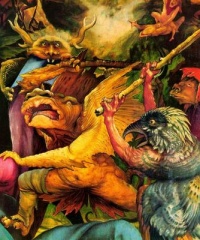Hallucination
From The Art and Popular Culture Encyclopedia
|
"In short, the nature of the hallucinations of Jesus, as they are described in the orthodox Gospels, permits us to conclude that the founder of Christian religion was afflicted with religious paranoia."--Charles Binet-Sanglé cited in The Psychiatric Study of Jesus (1913) by Albert Schweitzer "[Demons] taking the forms of women, wild beasts, creeping things."--Life of Antony "The senses become extraordinarily acute and fine. The eyes pierce Infinity. The ear seizes the most unseizable sounds in the midst of the shrillest noises. Hallucinations commence."--Les Paradis artificiels (1860) by Charles Baudelaire, translation via Baudelaire: His Prose and Poetry (1919) "Her husband then, at her request, ascended the tree, and she at once called her paramour, and began to amuse herself with him. Her husband saw her from his post in the tree, and began to abuse her; but she declared there was no man with her, and that the pear-tree made her husband see double, just as it had made her see double previously."--Whinfield translation of the Masnavi |
|
Related e |
|
Featured: |
A hallucination in the broadest sense is a perception in the absence of a stimulus. In a stricter sense, hallucinations are defined as perceptions in a conscious and awake state in the absence of external stimuli and that have qualities of real perception in that they are vivid, substantial, and located in external objective space. These definitions distinguish hallucinations from the related phenomena of dreaming (no consciousness), illusion (distorted or misinterpreted real perception), imagery (does not mimic real perception and is under voluntary control), and pseudohallucination (does not mimick real perception, but is not under voluntary control).
Hallucinations also differ from "delusional perceptions", in which a correctly sensed and interpreted genuine perception is given some additional (and typically bizarre) significance.
Hallucinations may occur in any sensory modality—visual, auditory, olfactory, gustatory, tactile, proprioceptive, equilibrioceptive, nociceptive, and thermoceptive.
A mild form of hallucination is known as a disturbance, and can occur in any of the senses above. These may be things like seeing movement in peripheral vision, or hearing faint noises and voices.
Hypnagogic hallucinations and hypnopompic hallucinations are considered normal phenomena. Hypnagogic hallucinations can occur as one is falling asleep and hypnopompic hallucinations occur when one is waking up. Hallucinations may also be associated with drug use (particularly deliriants), sleep deprivation, psychosis, neurological disorders, and delirium tremens.
See also
- Hallucination (artificial intelligence)
- Phantosmia
- Pseudohallucination
- Closed-eye hallucination
- Dimethyltryptamine
- Folie à deux
- Ganzfeld effect
- Hallucinogenic fish
- Anomalous experiences
- Illusion
- Hypnagogia
- Microwave auditory effect
- Phantom eye syndrome
- Phosphene
- Prisoner's cinema
- Psychedelic experience
- Hallucinogen persisting perception disorder HPPD
- Psychotic depression
- Simulated reality
- Vision (spirituality)
- Schizophrenia
- Bicameral mentality
- Apparitional experience
- Phantom limb
Namesakes
- The Hollywood Hallucination (1944) by Parker Tyler
- Hallucination Engine (1994) - Material


